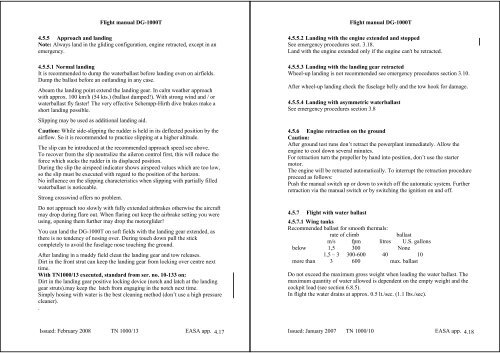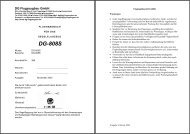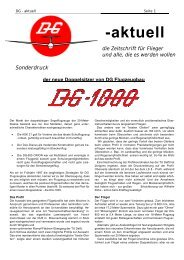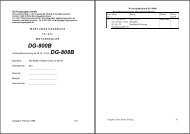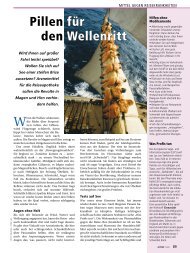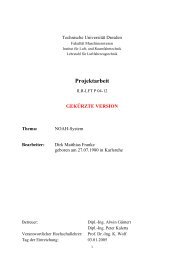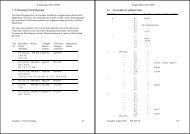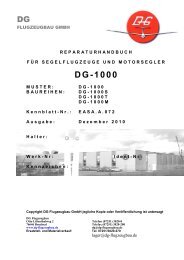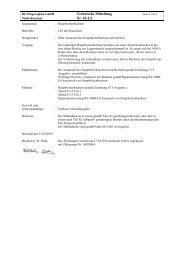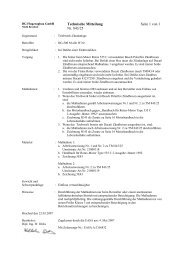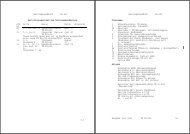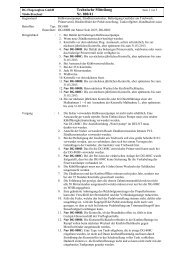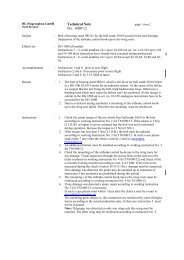DG-1000T - DG Flugzeugbau
DG-1000T - DG Flugzeugbau
DG-1000T - DG Flugzeugbau
Create successful ePaper yourself
Turn your PDF publications into a flip-book with our unique Google optimized e-Paper software.
Flight manual <strong>DG</strong>-<strong>1000T</strong><br />
4.5.5 Approach and landing<br />
Note: Always land in the gliding configuration, engine retracted, except in an<br />
emergency.<br />
4.5.5.1 Normal landing<br />
It is recommended to dump the waterballast before landing even on airfields.<br />
Dump the ballast before an outlanding in any case.<br />
Abeam the landing point extend the landing gear. In calm weather approach<br />
with approx. 100 km/h (54 kts.) (ballast dumped!). With strong wind and / or<br />
waterballast fly faster! The very effective Schempp-Hirth dive brakes make a<br />
short landing possible.<br />
Slipping may be used as additional landing aid.<br />
Caution: While side-slipping the rudder is held in its deflected position by the<br />
airflow. So it is recommended to practice slipping at a higher altitude.<br />
The slip can be introduced at the recommended approach speed see above.<br />
To recover from the slip neutralize the aileron control first, this will reduce the<br />
force which sucks the rudder in its displaced position.<br />
During the slip the airspeed indicator shows airspeed values which are too low,<br />
so the slip must be executed with regard to the position of the horizon.<br />
No influence on the slipping characteristics when slipping with partially filled<br />
waterballast is noticeable.<br />
Strong crosswind offers no problem.<br />
Do not approach too slowly with fully extended airbrakes otherwise the aircraft<br />
may drop during flare out. When flaring out keep the airbrake setting you were<br />
using, opening them further may drop the motorglider!<br />
You can land the <strong>DG</strong>-<strong>1000T</strong> on soft fields with the landing gear extended, as<br />
there is no tendency of nosing over. During touch down pull the stick<br />
completely to avoid the fuselage nose touching the ground.<br />
After landing in a muddy field clean the landing gear and tow releases.<br />
Dirt in the front strut can keep the landing gear from locking over centre next<br />
time.<br />
With TN1000/13 executed, standard from ser. no. 10-133 on:<br />
Dirt in the landing gear positive locking device (notch and latch at the landing<br />
gear struts).may keep the latch from engaging in the notch next time.<br />
Simply hosing with water is the best cleaning method (don’t use a high pressure<br />
cleaner).<br />
.<br />
Issued: February 2008 TN 1000/13 EASA app. 4.17<br />
Flight manual <strong>DG</strong>-<strong>1000T</strong><br />
4.5.5.2 Landing with the engine extended and stopped<br />
See emergency procedures sect. 3.18.<br />
Land with the engine extended only if the engine can't be retracted.<br />
4.5.5.3 Landing with the landing gear retracted<br />
Wheel-up landing is not recommended see emergency procedures section 3.10.<br />
After wheel-up landing check the fuselage belly and the tow hook for damage.<br />
4.5.5.4 Landing with asymmetric waterballast<br />
See emergency procedures section 3.8<br />
4.5.6 Engine retraction on the ground<br />
Caution:<br />
After ground test runs don’t retract the powerplant immediately. Allow the<br />
engine to cool down several minutes.<br />
For retraction turn the propeller by hand into position, don’t use the starter<br />
motor.<br />
The engine will be retracted automatically. To interrupt the retraction procedure<br />
proceed as follows:<br />
Push the manual switch up or down to switch off the automatic system. Further<br />
retraction via the manual switch or by switching the ignition on and off.<br />
4.5.7 Flight with water ballast<br />
4.5.7.1 Wing tanks<br />
Recommended ballast for smooth thermals:<br />
rate of climb ballast<br />
m/s fpm litres U.S. gallons<br />
below 1,5 300 None<br />
1,5 – 3 300-600 40 10<br />
more than 3 600 max. ballast<br />
Do not exceed the maximum gross weight when loading the water ballast. The<br />
maximum quantity of water allowed is dependent on the empty weight and the<br />
cockpit load (see section 6.8.5).<br />
In flight the water drains at approx. 0.5 lt./sec. (1.1 lbs./sec).<br />
Issued: January 2007 TN 1000/10 EASA app. 4.18


